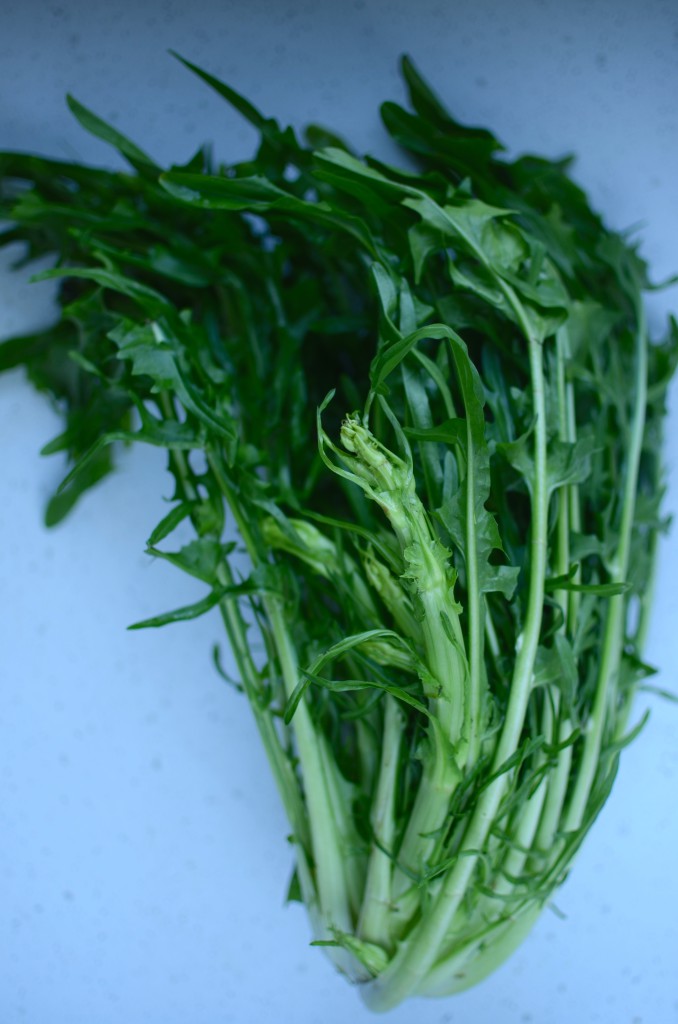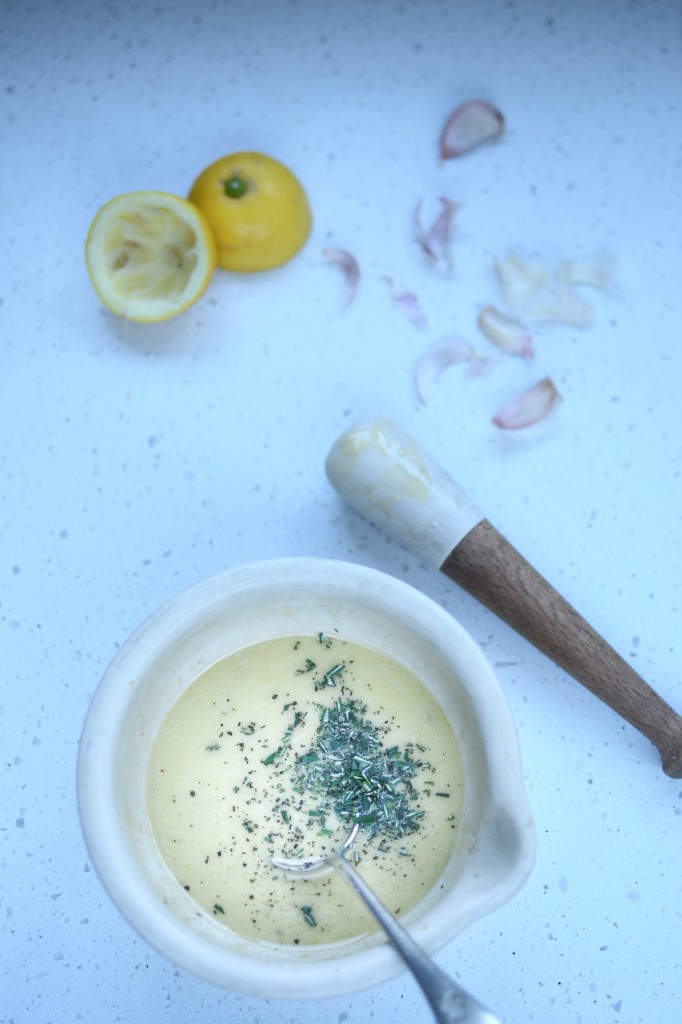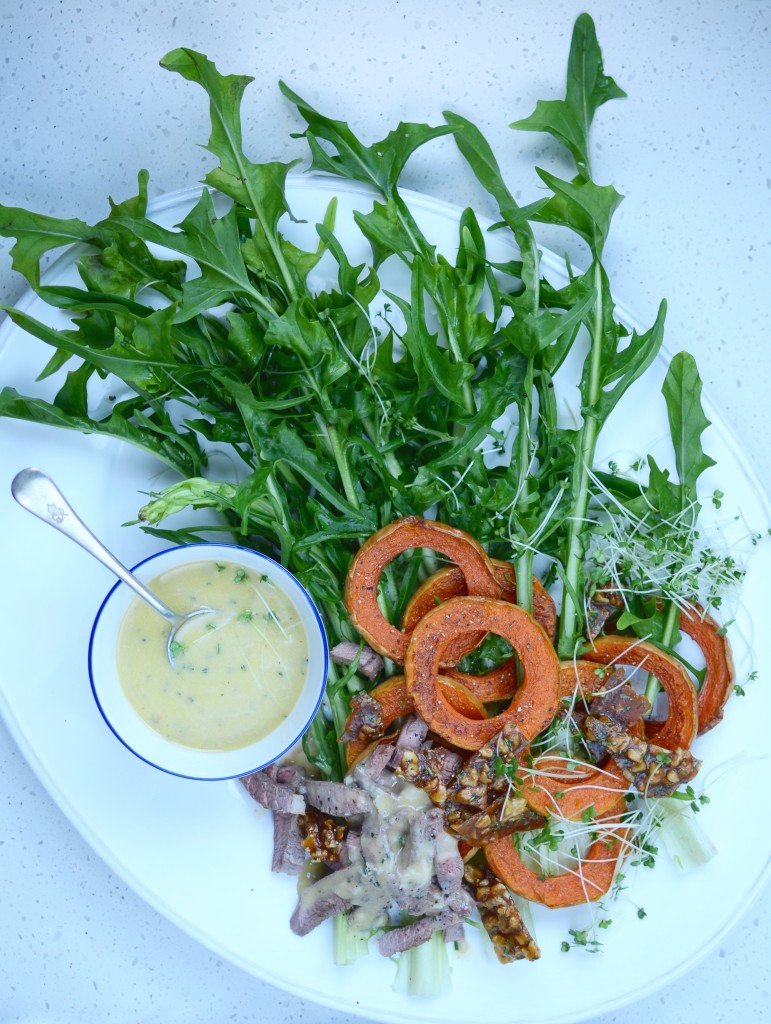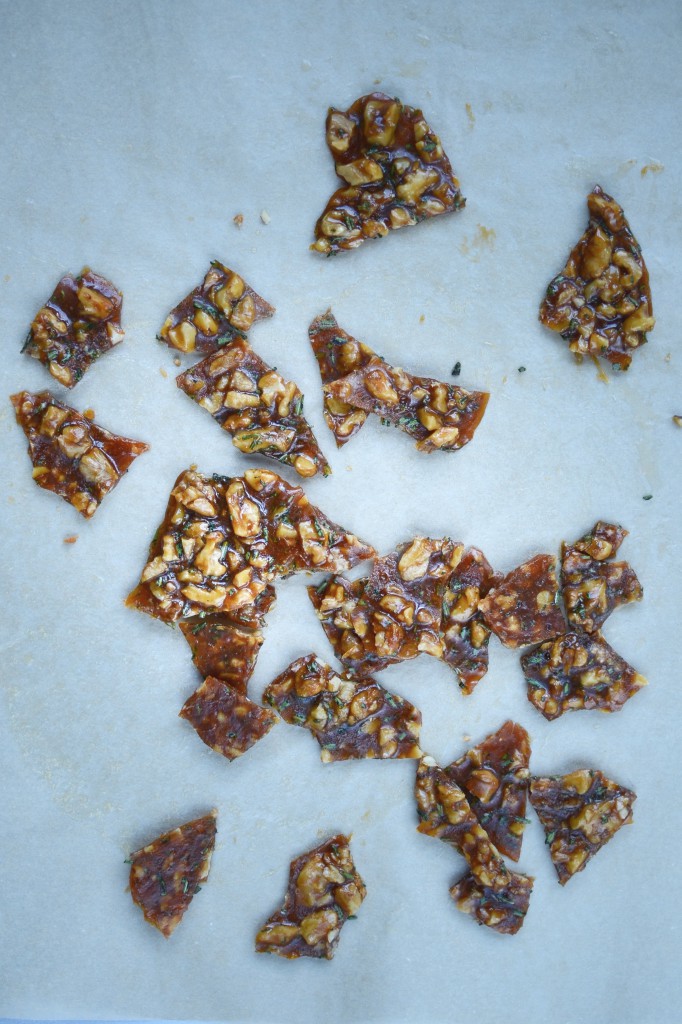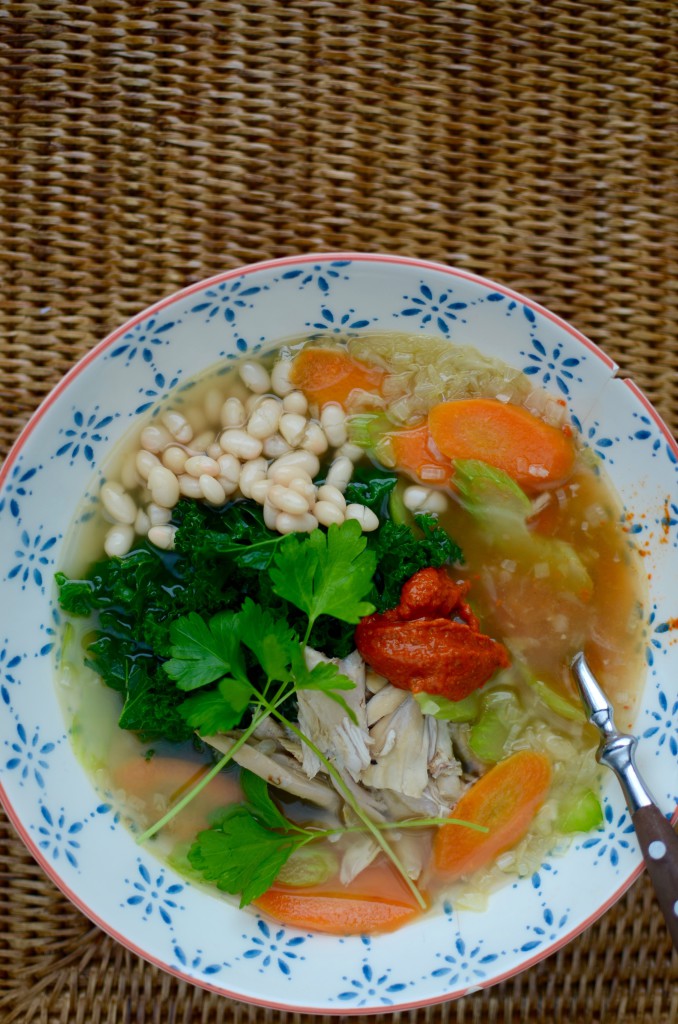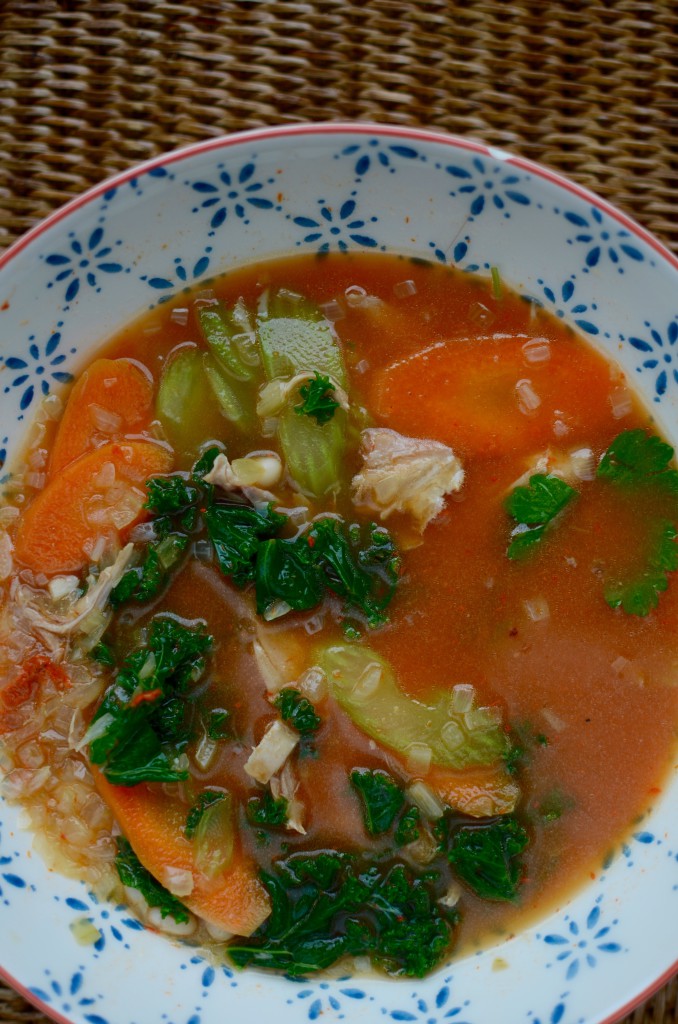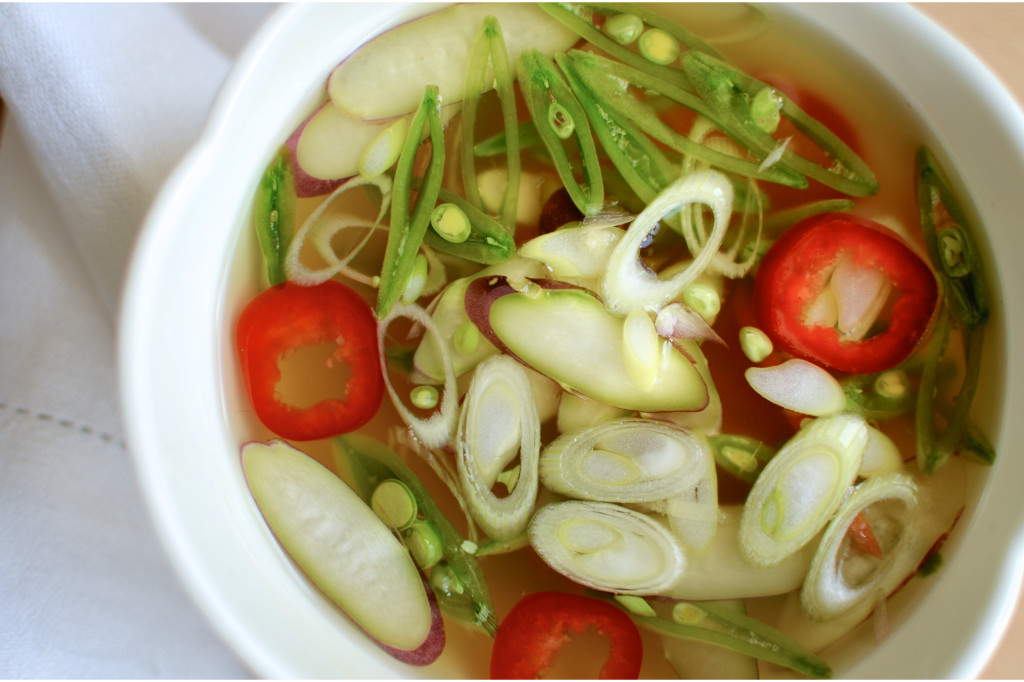Lamb steak, puntarelle and rosemary brittle
I love the Italians! Not only do they know how to live passionately, but they also rock on the green vegetable front, especially when it comes to bitter greens. One of my favourites is puntarelle or catalogna – a loose leafed variety of chicory favoured by most Romans, also referred to as Catalonian or asparagus chicory. The word “puntarelle” actually refers to the pale green inner stalks that have asparagus-like tips, whilst the outer leaves are similar to dandelion both in taste (they are very bitter!) and appearance. If you would like a step-by-step tutorial on how to prepare this vegetable, Nick Anderer explains it all here. For a quick overview, I’ve included the steps below. This fabulous vegetable is only in season in the colder months, but with Easter a little earlier than usual, perhaps this salad will still be a possible addition to your festive feast! It will be equally good with dandelion greens, chicory and radicchio, however, if you cannot find puntarelle.
Lamb steak, puntarelle and rosemary brittle
Ingredients for the salad
2 lamb steaks
splash of extra virgin olive oil
2 – 3 sprigs of rosemary
2 – 3 large garlic cloves, peeled and sliced
1 butternut or coquina squash, cut into rings and roasted until tender
1 head of puntarelle
Ingredients for the brittle
85g (just under 1/2 cup) unrefined brown sugar
50g (1/2 cup) chopped walnuts
15g (1 tablespoon) unsalted butter
1 tablespoon finely chopped fresh rosemary
1/2 teaspoon course ground sea salt
Ingredients for the dressing
2 cloves garlic
1/2 teaspoon coarse sea salt
1 tablespoon finely chopped fresh rosemary
5 – 6 marinated anchovies, drained
30ml (2 tablespoons) mayonnaise (preferably home-made)
80ml (1/3 cup) extra virgin olive oil
30ml (2 tablespoons) fresh lemon juice
Method
- Rub a little olive oil into the meat, then place into a shallow glass dish and press the rosemary and garlic on top. Allow to marinade for a couple of hours, then remove the rosemary and garlic, season with salt and pepper, and fry on a griddle until cooked to your liking. Set aside to rest for 10 minutes before slicing.
- For the puntarelle:
- Fill a large bowl with ice water and set aside. Strip away the dark green outer leaves – you will only need a handful of these to add to the salad. Use a sharp paring knife to separate the pale green core into its individual stalks, then thinly slice each lengthwise before dropping the slivers into the ice water. They need to soak for at least 45 minutes to achieve the traditional curly crispness that puntarelle is loved for.
- For the brittle:
- Line a large baking sheet with greaseproof paper.
- Place the sugar in a medium heavy saucepan over medium high heat and stir with a wooden spoon until sugar begins to melt. Lower the heat a little and keep stirring until all the sugar has melted.
- Now leave it to cook untouched until it is a dark caramel colour – you should be able to smell it. Stir in the walnuts and butter, and allow to cook for another couple of minutes, stirring constantly, or until the butter is incorporated.
- Stir in the rosemary and salt, then scrape the mixture out onto the prepared baking sheet. Spread it evenly to the desired thickness with a wooden spoon or stiff rubber spatula. Allow to cool completely (roughly one hour) then break it into pieces. You will probably have slightly more than you need for this salad, but the rest can be stored in an airtight container at room temperature and will keep a few days.
- For the dressing:
- Place the garlic and coarse salt in a mortar and grind into a paste.
- Add the rosemary and continue to grind until it is well mixed and resembles a speckled pulp.
- Add the anchovies and repeat until you have a thick paste.
- Now slowly whisk in the olive oil until it is incorporated, followed by the mayonnaise and lemon juice.
- To assemble your salad, combine the sliced lamb, roughly chopped puntarelle greens, drained and dried puntarelle stalks and roasted squash, and toss with enough dressing to coat. Scatter over the brittle and serve immediately.
Harissa chicken soup
It suddenly got really cold. I had the privilege of spending the weekend in the Cotswolds with some girlfriends, where the icy polar wind whipped around our ears and brought tears to my eyes. All we could think of was the warm barn and lovingly cupping some warm(ing) drinks. I returned to London rejuvenated, and in the mood for soup. Not just any old soup, though – a slightly spicy chicken soup!
Serves 4
Ingredients for the spice paste (makes about 200ml)
2 red bell peppers, halved and seeds removed
1 teaspoon caraway seeds
2 teaspoons coriander seeds
2 teaspoons cumin seeds
pinch of dried chilli flakes, to taste
1/2 teaspoon sea salt
1 large or 2 small garlic cloves, peeled
1 teaspoon sweet paprika powder
50g (about 10 halves) sun-dried tomatoes marinated in olive oil
1 – 2 tsp lemon juice
Ingredients for the soup
some olive oil or coconut oil
2 small onions, peeled and finely diced
2 cloves garlic, peeled and finely sliced
bay leaf
4 medium carrots, thinly sliced
2 large celery stalks, thinly sliced
4 large handfuls shredded kale, thick stalks discarded and blanched in boiling water
1.25l good-quality chicken stock, preferably home-made using bones from pastured animals
sea salt
To serve
Parsley sprigs
Small handful shredded roast chicken per person
Cooked beans such as haricot or cannellini
Method
- For the peppers, roast cut sides up in a moderate oven (180°C/360°F) for about 1 hour, or until tender and caramelised around the edges. You could also use good quality ready-roasted red peppers from the deli counter.
- In the meantime, dry roast the seeds in a medium hot pan until fragrant. Tip into a mortar and once cooled, grind into a powder.
- Put all the ingredients for the spice paste into a blender and blend until smooth. Adjust seasoning and set aside.
- For the soup, heat the oil over a moderate heat and sweat the onions and garlic until soft. Add the bay leaf, carrots and celery, and gently cook for another few minutes until just tender.
- Add the blanched kale and the chicken stock and simmer for a few minutes.
- Adjust seasoning, and serve with shredded chicken, cooked beans and lots of spice paste.
Bone broth with spring vegetables
When my little one awoke with a temperature the other day, the chicken in my fridge was only ever destined for one thing: ultra-nourishing bone broth. Making broths (or stock) is one of those kitchen tasks that gives the impression of being very time-consuming and ultimately not worth the effort. This could not be further from the truth, however. Stock made with the bones of healthy, pasture-raised animals is not only useful (add it to stews, soups, sauces and grains) and more delicious than stock cubes, but also much more health-supportive.
“Real stock” (for lack of a better expression) contains minerals (calcium, magnesium, phosphorus, silicon, sulfur and trace minerals) in a form the body can absorb easily. It also contains the broken down material from cartilage and tendons, like chondroitin sulphates and glucosamine, that are beneficial in treating joint pain. The gelatin found in bone broth is a hydrophilic colloid that attracts and holds liquids, including digestive juices, thereby supporting proper digestion. It also keeps hair and nails healthy. Many reasons to start adding this pantry basic to your repertoire.
Ingredients for homemade chicken broth
1 whole organic, free-range chicken carcass, with some meat left on the bone and cut into smaller pieces
2 tablespoons apple cider vinegar
1 large onion, peeled and coarsely chopped
2 carrots, peeled and coarsely chopped
3 celery stalks, washed and coarsely chopped
1 leek, washed and sliced into chunks
1 bunch parsley, stalks only (reserve leaves to add for the final 10 minutes)
2 bay leaves
5 fresh thyme stalks
5 black pepper corns
Method
- Place all the ingredients in a large pot and cover with fresh filtered water.
- Bring to a boil, and remove any scum that rises to the top, then reduce the heat to a simmer.
- The stock needs to simmer for at least 4 hours, but preferably 8 hours or more.
- Once your stock is ready, strain it as soon as possible and use immediately, refrigerate or freeze.
- For a quick and tasty meal, season with salt and pepper, and add thin slivers of raw purple and green asparagus, spring onions (or salad onions), sugar snap peas, red pepper and carrot. I usually also add finely grated fresh ginger and fresh chili.
Note: The vinegar helps leech the valuable minerals from the bones into the stock water.

